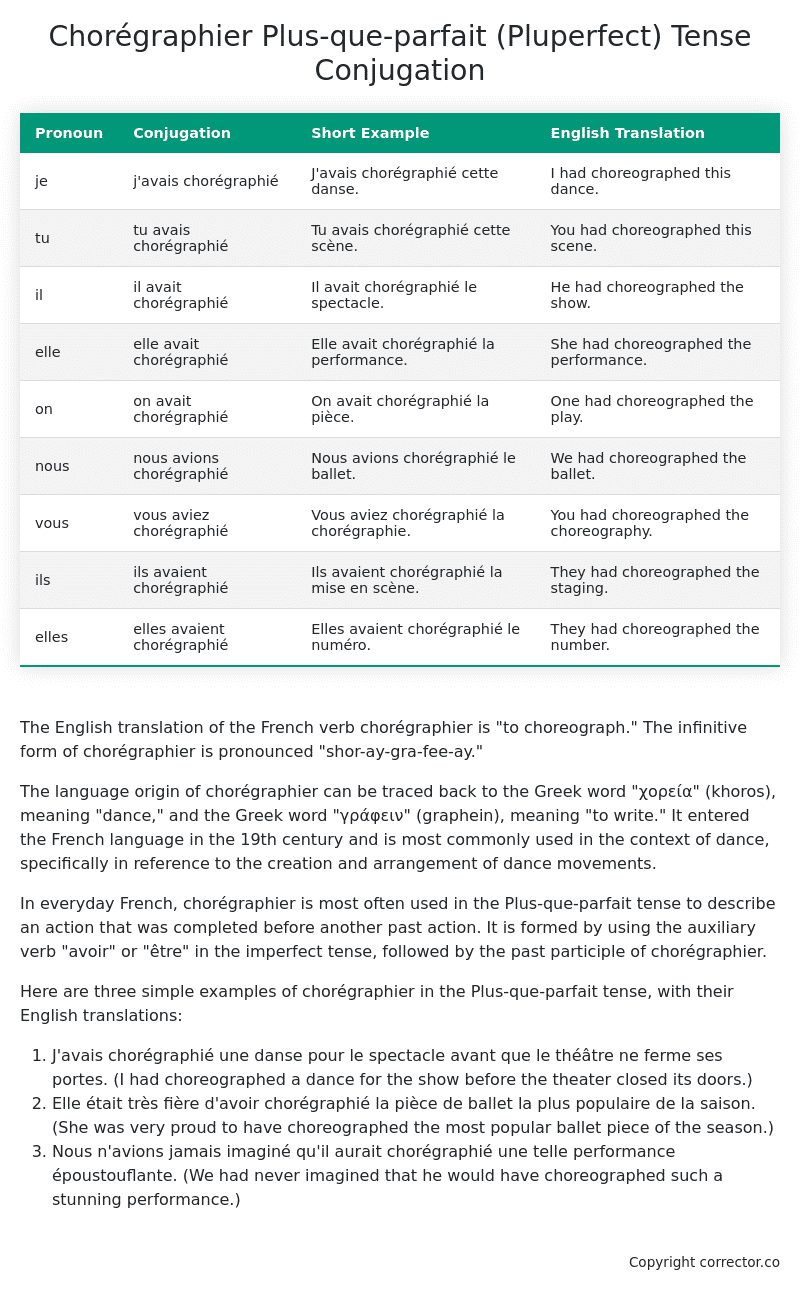Plus-que-parfait (Pluperfect) Tense Conjugation of the French Verb chorégraphier
Introduction to the verb chorégraphier
The English translation of the French verb chorégraphier is “to choreograph.” The infinitive form of chorégraphier is pronounced “shor-ay-gra-fee-ay.”
The language origin of chorégraphier can be traced back to the Greek word “χορεία” (khoros), meaning “dance,” and the Greek word “γράφειν” (graphein), meaning “to write.” It entered the French language in the 19th century and is most commonly used in the context of dance, specifically in reference to the creation and arrangement of dance movements.
In everyday French, chorégraphier is most often used in the Plus-que-parfait tense to describe an action that was completed before another past action. It is formed by using the auxiliary verb “avoir” or “être” in the imperfect tense, followed by the past participle of chorégraphier.
Here are three simple examples of chorégraphier in the Plus-que-parfait tense, with their English translations:
- J’avais chorégraphié une danse pour le spectacle avant que le théâtre ne ferme ses portes. (I had choreographed a dance for the show before the theater closed its doors.)
- Elle était très fière d’avoir chorégraphié la pièce de ballet la plus populaire de la saison. (She was very proud to have choreographed the most popular ballet piece of the season.)
- Nous n’avions jamais imaginé qu’il aurait chorégraphié une telle performance époustouflante. (We had never imagined that he would have choreographed such a stunning performance.)
Table of the Plus-que-parfait (Pluperfect) Tense Conjugation of chorégraphier
| Pronoun | Conjugation | Short Example | English Translation |
|---|---|---|---|
| je | j’avais chorégraphié | J’avais chorégraphié cette danse. | I had choreographed this dance. |
| tu | tu avais chorégraphié | Tu avais chorégraphié cette scène. | You had choreographed this scene. |
| il | il avait chorégraphié | Il avait chorégraphié le spectacle. | He had choreographed the show. |
| elle | elle avait chorégraphié | Elle avait chorégraphié la performance. | She had choreographed the performance. |
| on | on avait chorégraphié | On avait chorégraphié la pièce. | One had choreographed the play. |
| nous | nous avions chorégraphié | Nous avions chorégraphié le ballet. | We had choreographed the ballet. |
| vous | vous aviez chorégraphié | Vous aviez chorégraphié la chorégraphie. | You had choreographed the choreography. |
| ils | ils avaient chorégraphié | Ils avaient chorégraphié la mise en scène. | They had choreographed the staging. |
| elles | elles avaient chorégraphié | Elles avaient chorégraphié le numéro. | They had choreographed the number. |
Other Conjugations for Chorégraphier.
Le Present (Present Tense) Conjugation of the French Verb chorégraphier
Imparfait (Imperfect) Tense Conjugation of the French Verb chorégraphier
Passé Simple (Simple Past) Tense Conjugation of the French Verb chorégraphier
Passé Composé (Present Perfect) Tense Conjugation of the French Verb chorégraphier
Futur Simple (Simple Future) Tense Conjugation of the French Verb chorégraphier
Futur Proche (Near Future) Tense Conjugation of the French Verb chorégraphier
Plus-que-parfait (Pluperfect) Tense Conjugation of the French Verb chorégraphier (this article)
Passé Antérieur (Past Anterior) Tense Conjugation of the French Verb chorégraphier
Futur Antérieur (Future Anterior) Tense Conjugation of the French Verb chorégraphier
Subjonctif Présent (Subjunctive Present) Tense Conjugation of the French Verb chorégraphier
Subjonctif Passé (Subjunctive Past) Tense Conjugation of the French Verb chorégraphier
Subjonctif Imparfait (Subjunctive Imperfect) Tense Conjugation of the French Verb chorégraphier
Conditionnel Présent (Conditional Present) Tense Conjugation of the French Verb chorégraphier
Conditionnel Passé (Conditional Past) Tense Conjugation of the French Verb chorégraphier
L’impératif Présent (Imperative Present) Tense Conjugation of the French Verb chorégraphier
L’infinitif Présent (Infinitive Present) Tense Conjugation of the French Verb chorégraphier
Struggling with French verbs or the language in general? Why not use our free French Grammar Checker – no registration required!
Get a FREE Download Study Sheet of this Conjugation 🔥
Simply right click the image below, click “save image” and get your free reference for the chorégraphier Plus-que-parfait tense conjugation!

Chorégraphier – About the French Plus-que-parfait (Pluperfect) Tense
Tense Formation
Common everyday usage patterns
Sequencing of past events
Background information
Hypothetical or reported speech
Interactions with other tenses
Summary
I hope you enjoyed this article on the verb chorégraphier. Still in a learning mood? Check out another TOTALLY random French verb conjugation!


